Asparagus beds last 20 or more years and take quite a while to reach peak production. That creates a lot of pressure to get it right the first time! Because of the high stakes here, I've reviewed a dozen different research papers and consulted experts in order to provide you with the most accurate information.
Jump to:
- How does asparagus actually grow?
- How much does each plant produce?
- Where does asparagus grow?
- Planning your site & buying crowns
- How to grow asparagus
- Annual growth cycle of asparagus
- How to harvest
- Harvest timeline
- Yield in your garden
- When to stop harvesting & post harvest care
- Ready for harvest
- More asparagus guides
- Sources
How does asparagus actually grow?
If this is the first time you are planting asparagus, you probably have more questions than answers. Asparagus can be grown from seed, but it is most commonly grown from an established plant that is 1-2 years old.
Those plants are dug up at the farm (or nursery) when they are dormant and sold as "asparagus crowns." To help you successfully grow these in your home garden, I want to explain the asparagus growth cycle, starting with the crown.

Bare root asparagus crowns
This is what a bare root asparagus crown looks like when you buy it. It will already be 1-2 years old. The crown gets dug up when it's dormant. Think of this part of the growth cycle similar to a tree that lost its leaves in winter - it's dormant, but not dead.
The asparagus crown is the main part at the top which gets buried 8" underground. It will develop buds that grow into spears (the part we eat). As the spears grow, they soak up sunlight and send the energy to the roots which can eventually grow as deep as 6 feet.
Asparagus are perennial plants, coming back every year, so it's important to pick a location they will thrive in for the next 15-20 years.
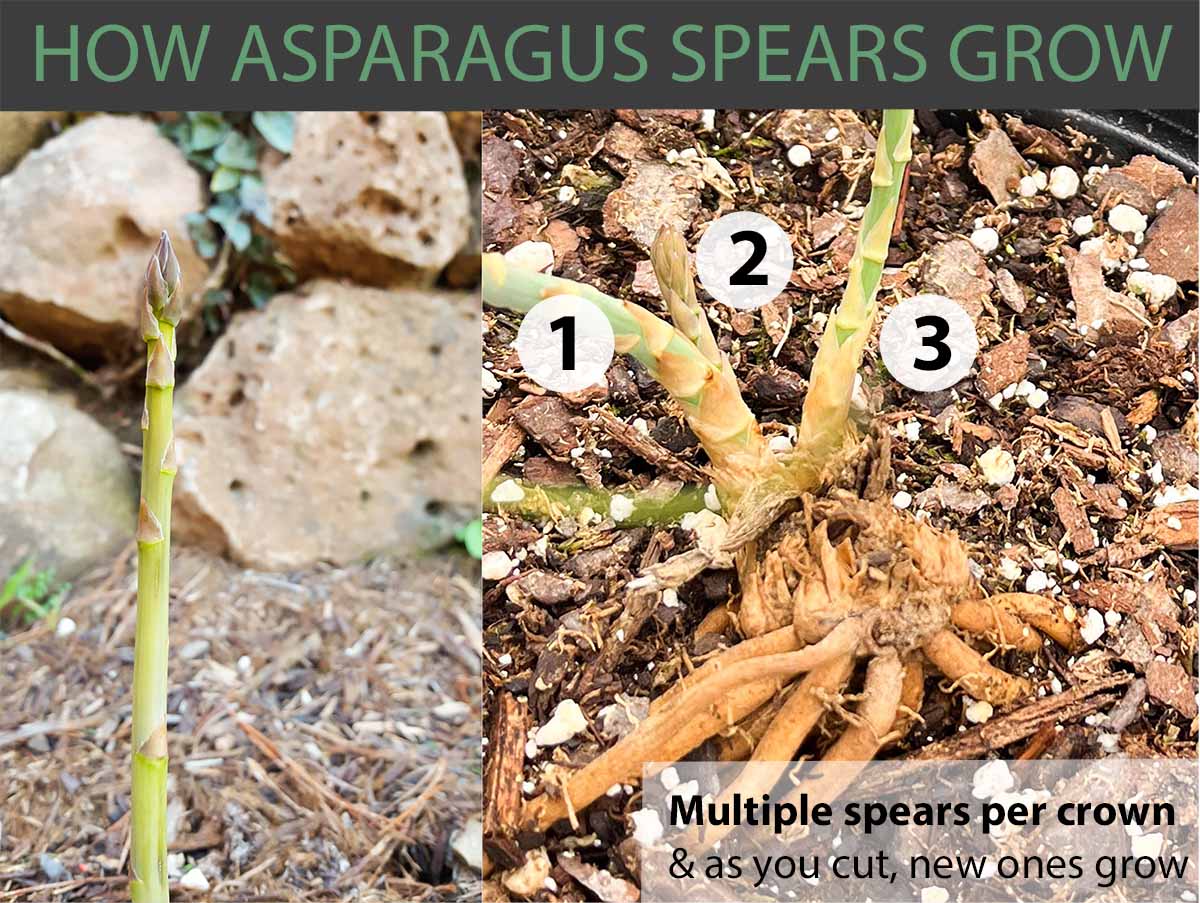
How spears grow
In spring once the weather barely begins to warm up, asparagus breaks dormancy. The plants enter a vigorous growth cycle, shooting spears up above ground.
Each asparagus plant usually sends up multiple spears. The spears grow fast, especially as the weather continues to warm up (between 75-80F). They can grow up to 2" a day - it's fun to watch.
When a spear is harvested, buds below the soil push up new spears. Young plants might produce only 1 or 2 spears its first year. As it ages, a healthy asparagus plant can produce 10-15 spears during its peak years (around the 7th harvest year). That means each crown you planted will yield 10-15 spears over the harvest season.

Asparagus ferns out
Asparagus is harvested when the stalks are 6-9" tall and the tips are closed & tight. However, when they are left to grow, the tips open up and form buds (not the same buds as the crown produces underground!).
The buds on the asparagus tips continue to grow into branches with foliage similar to a fern, hence the term, 'ferning out.' It actually looks very similar to fennel and can be indistinguishable from a distance!
Ferning out is part of the asparagus growth cycle. When you stop harvesting the spears, new ones shoot up that you let grow and fern out. This lets the plant collect energy from the sunlight and send it back to the roots for storage over the winter. In spring, the stored energy allows the plant to send up new spears for harvest!
Sometime in fall, the asparagus ferns dry out and turn brown. At this point you can cut them down.
How much does each plant produce?
During peak production year (starting around year 7), you can expect asparagus to yield the following:
- ½ - ¾ pound per crown per season (about 10-15 spears)
- 25 crowns yields 12-18 pounds per season
- That's about 2-3 pounds per week (over 8 weeks)
Each crown will produce about 10 spears during its most productive years, which is about half a pound. You may even get up to ¾ pound per crown, according to some sources, like Utah State.
Early years produce less while the plants get established. How much less? Based on data from several research trials at various universities, there appears to be a trend:
- Year 2: (first time you can harvest), has minimal yields
- Year 3: produces about 33% of peak (4-5 lbs per 25 crowns)
- Year 4-5: production continues to increase to 45-55% of peak
- Year 6: production is at about 66% of peak (8-10 lbs per 25 crowns)
- Year 7-8: peak production is reached
- Year 10 and later: production declines about 5% per year, according to farmers
Many farmers stop harvesting their asparagus fields after 15 years because product declines lose profitability. But the home gardener can continue to harvest for likely 30 years or more.
Where does asparagus grow?
Asparagus grows well throughout most of the US, withstanding temperatures from USDA zone 2-9. It can actually handle very cold regions, even into Canada. Hot southern regions without a cool spell in winter can struggle, but dedicated gardeners have even persisted in Florida. Look for varieties suited for your climate.
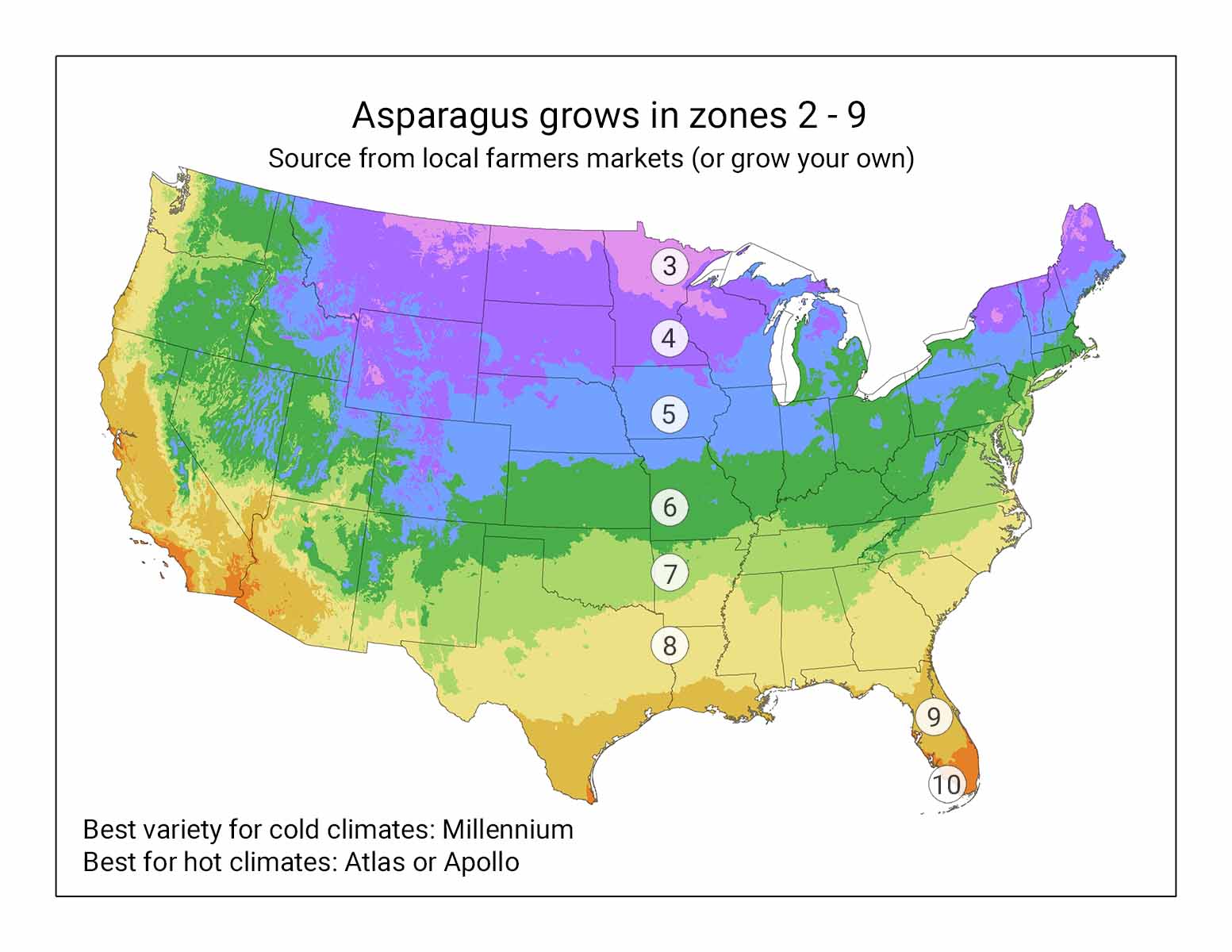

Planning your site & buying crowns
Asparagus beds will last 15-30 years, which is why it's worth spending time to pick the variety that suits your needs and a planting site that will thrive.
Most people are happy with 12 asparagus plants per person, unless they want extra to share, to preserve, or to have a larger harvest sooner. In that case, those people opt for 25 plants per person if they have the space.
This guide helps you determine how much asparagus to plant per person.
Temperature & soil requirements
They thrive in full sun with daytime temperatures that reach 70-85 degrees Fahrenheit. Warmer temperatures cause them to grow fast and fern out on shorter spears (which can also cause woodiness). Some varieties perform better in colder or warmer climates.
Asparagus also prefers well draining soil, but some varieties like Millennium can handle heavier soils with clay. It's common advice that asparagus doesn't like wet feet, which can cause the roots to rot, however several books on rain gardens claim that asparagus can live happily and actually helps soak up water with its deep roots.The best soil pH is neutral, around 6.5-7.0. Slightly higher and lower can be tolerated.
Setting aside enough space
Asparagus crowns can be planted quite efficiently without affecting the yield or quality. You can actually plant 25 crowns in 36 square feet. Compare that to traditional spacing guidelines (12-18 inches apart with 3-5 feet between rows), which requires 100 square feet for 25 crowns.
If you're still short on space, you can plant the crowns in a single row, 6 inches apart as explained in the guide on how to grow asparagus in less space.
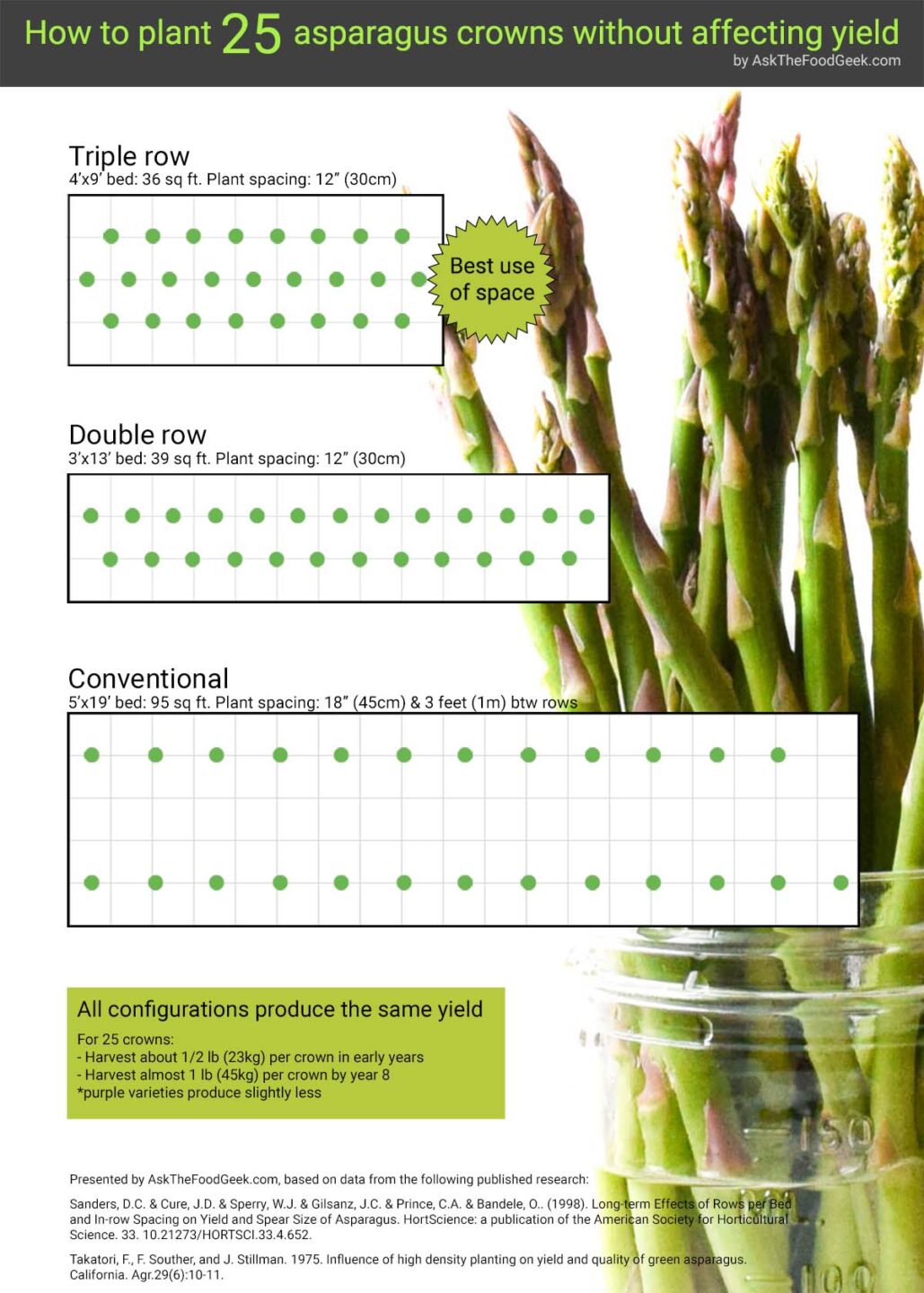
Choosing varieties
Asparagus plants are either male or female. Open pollinated varieties have both male and female plants, whereas hybrid varieties have been created with all-male plants.
Why does this matter? These all-male hybrids were created because male plants produce significantly higher yields, from 50% up to 3 times more than open-pollinated varieties. Female plants produce less spears, but they tend to be slightly larger.
- Mary Washington: green, heirloom, open-pollinated variety
- Millennium: green, all-male hybrid, very high yielding, very cold hardy.
- Apollo: green, open-pollinated variety, more tolerant of heat
- Atlas: green, open-pollinated variety, more tolerant of heat
- Purple Passion: purple, open-pollinated variety. Larger spears and 20% more sugar than green varieties.
- Pacific Purple: purple, open-pollinated variety. Larger spears and 20% more sugar than green varieties.
- UC-157: green, open-pollinated variety, doesn't do as well in cold climates. Usually only sold as seed.
- Jersey Knight, Jersey Supreme, and other Jersey Series: discontinued. (All male-hybrid, green).
Read the guide on asparagus varieties for your climate.
How to grow asparagus

1. Dig a trench
Asparagus crowns are planted below the soil level in a trench, called a furrow. The crowns are placed in the trench then covered with a couple inches of soil, but the trench isn't filled to the top (yet!). After the first shoots start to come through the soil, then the rest of the trench is filled.
- Sandy soil: 8-10" deep
- Silt and loamy soil: 8" deep
- Clay soil: 5-6" deep
Consider planting the crowns in a double or triple row, where the rows are 12 inches (30cm) apart. In this case, dig 2 to 3 trenches, 12" apart on center. See "How to grow asparagus in less space" for more information."

2. Soak crowns
Right before planting, so the crowns in water for 30 minutes to an hour. Any longer and you might be risking some rot damage. This step helps hydrate the roots before planting even more than watering the soil (which you will also do after planting).

3. Plant crowns
Crowns are placed in the furrows head to toe (bud to root) 12" apart. There is no need to fan the roots out. According to the University of Minnesota, "Some older growing guides recommend this practice, which is often referred to as an “octopus formation,” but it is time-consuming, and research does not support the claim that it leads to improved plant health or vigor."
If you are only planting a single row, you can space the crowns as close as 6 inches (15cm) without lowering the yield.
For more details on these high-density plantings, see "How to grow asparagus in less space."
4. Partially fill trench & water
After you plant the crowns, quickly cover them with a couple inches of soil before they dry out. Water the plants and soil in the trench.
As spears start to emerge from the ground about 2-3 weeks later, you will add another couple inches of soil. Continue until the entire trench is filled over the season.
5. Keep the bed weed-free
Keep weeds out of the asparagus bed. The roots need to get established and competition from weeds can significantly slow that down.

6. Lets plants 'fern out' (do not harvest this year!)
The first summer you plant asparagus, don't cut any of the spears. Let them 'fern out.' This lets the plant soak up the sun and convert it to energy for the roots, creating a strong, healthy plant.
Delaying harvest until next year helps the plant produce good quality spears in the future. Harvesting too soon (or too long in subsequent years) results in super skinny spears that are limp and thinner than a pencil.
Learn when & how to harvest asparagus spears.
7. Cut back dead ferns
Asparagus plants go dormant in winter and the above-ground ferns dry out and die back. Cut them down anytime after they have turned brown. Here are some considerations on the timing:
- Cut down in fall, as soon as they dry out: this can help remove overwintering asparagus beetles and diseases.
- Cut down in early spring: beneficial bugs that hang out in the ferns over winter are great food for migratory birds returning in spring.
Do not remove green ferns - as they are still alive and sending energy to the roots.
Annual growth cycle of asparagus
If you haven't grown asparagus before, I found that pictures help. Below are pictures of growing asparagus in my own garden the first year. It shows the phases asparagus goes through during its growth cycle each year.

Crowns planted: end of April
On April 27th, I planted asparagus crowns (this was 2 weeks before my last frost date in zone 5b). I also companion planted strawberries between the rows.
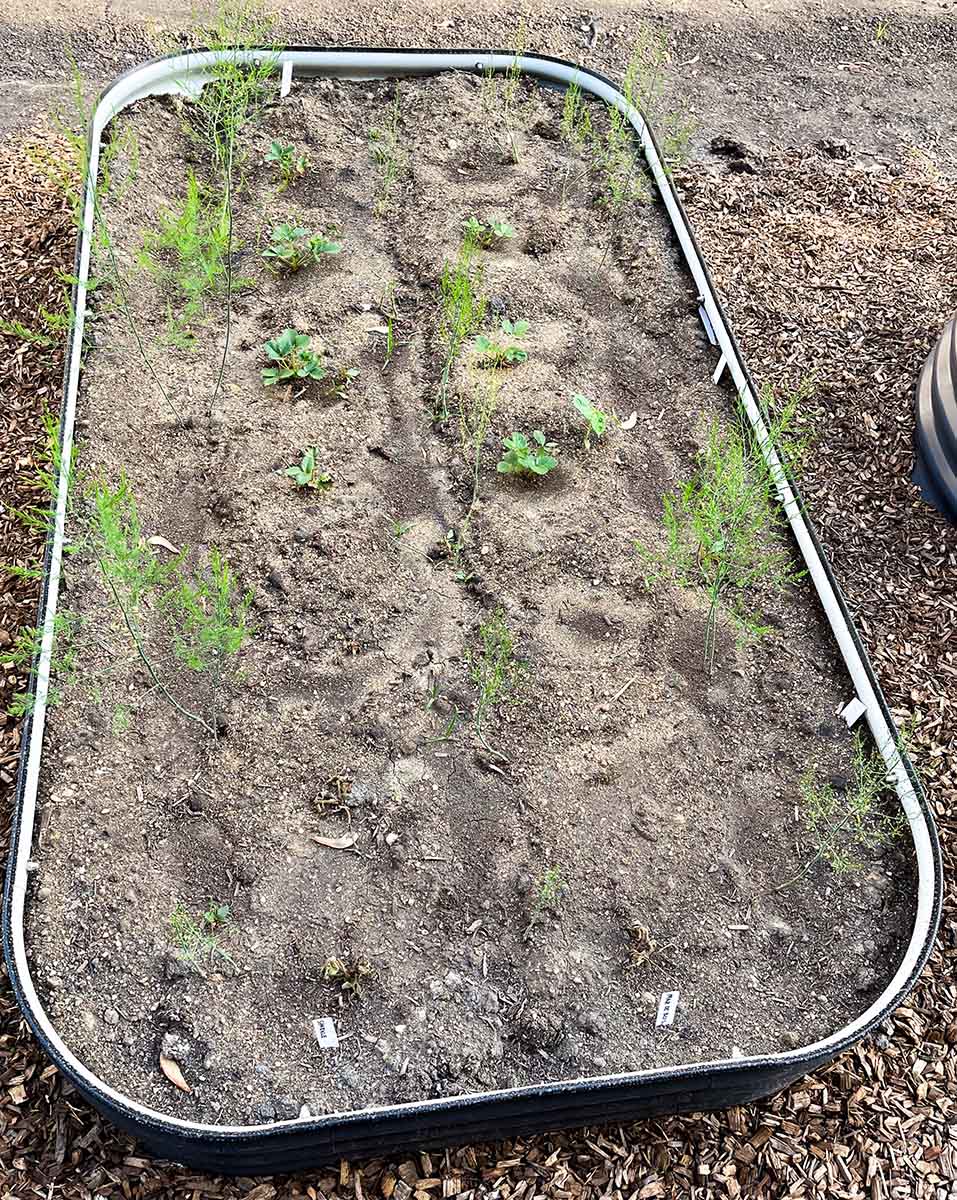
May
Throughout may, spears started emerging from the soil
On May 29th, each crown had produced at least one spear, which I did not harvest. They were left to fern out. Some crowns grew spears faster than others.

June & July
Throughout June, the spears continued to grow and fern out. They were slower than anticipated due to unusually high temperatures and a 6-week drought. City water doesn't help the plants thrive like rain water does (due to the added chlorine and salt content).
Also, a rabbit was caught munching on the asparagus and inter-planted strawberries!

August
On August 9th, the asparagus plants are ferned out and happy. A few baby spears were eaten down by rabbits last month and you can see new ones emerging in the front of this picture.

September
On September 4th, the asparagus plants were so tall they were falling over. The bed was totally filled, and they were shading out the strawberries.
How to harvest
You can harvest asparagus spears the second summer after you planted. Some people wait until the third year, but research shows harvesting for a short period in the second year increases yields in subsequent years.
Harvest while the tips are still tight and compact, before they fern out.

There are generally two methods to harvest asparagus spears:
- Use a knife and cut the spear below the soil
- Snap the spear off by hand, near ground level
Cutting below the soil
Many farmers use a knife and cut below the ground because the spears end up 20% longer. Since asparagus is sold by weight, this makes their harvest more profitable. In addition the University of Minnesota notes that, "the advantage to cutting spears below the soil is that the white, woody base restricts water loss, which preserves spear quality."
However, the portion of the spear that is below the dirt is usually very fibrous and tough - so it ends up getting trimmed off anyway. You'll know it when you see the white butt ends (they are white because the sunlight couldn't reach that part, so it wasn't able to turn green).
Snapping above the soil
The best way for most home gardeners to harvest asparagus is snap it off near the base. It should break before it hits any fibrous portion. The leftover stump will wither, and a new spear will grown from a bud underground.
The above-ground method is also better, because when using a knife below the soil, you might accidentally cut a bud or spear that has already started to grow, but isn't visible yet.
Storage
Ideally, you harvest spears right before you use them. Once harvested, they very quickly convert their sugars to starch, losing flavor and that super fresh quality. This happens very quickly over the first 24 hours, and then at a slower rate after that.
Storing harvested spears in the fridge slows that sugar conversion, preserving freshness. Asparagus can also be canned (in a pressure cooker), and frozen.
Harvest timeline
Asparagus crowns need time to establish - the stronger they are, the heavier the yields. Harvesting too much in their early years weakens the plant and your overall yield will suffer. The timeline below assumes you are planting 1-year old crowns.
- Year of planting (first summer): do not cut any spears
- 2nd summer: harvest spears for up to 2 weeks.
- 3rd summer: harvest spears for 4 - 6 weeks
- 4th year and beyond: harvest spears for 8-12 weeks
During harvest season, each crown shoots out a new spear that's ready to harvest in 2-4 days (depending on the weather and other growing conditions). If you haven't grown asparagus before, it's unreal to watch how quickly spears grow.
Yield in your garden
During peak production year (starting around year 7), you can expect:
- ½ - ¾ pound per crown per season (about 10-15 spears)
- 25 crowns yields 12-18 pounds per season
- That's about 2-3 pounds per week (over 8 weeks)
Each crown will produce about 10 spears during its most productive years, which is about half a pound. You may even get up to ¾ pound per crown, according to some sources, like Utah State.
While I haven't found any actual data from farms or test fields backing up the claims of higher ¾ lb yields, it is possible that home gardening outperforms farms with our higher level of pampering.
Early years produce less while the plants get established. How much less? Based on data from several research trials at various universities, there appears to be a trend:
- Year 2: (first time you can harvest), has minimal yields
- Year 3: produces about 33% of peak (4-5 lbs per 25 crowns)
- Year 4-5: production continues to increase to 45-55% of peak
- Year 6: production is at about 66% of peak (8-10 lbs per 25 crowns)
- Year 7-8: peak production is reached
- Year 10 and later: production declines about 5% per year, according to farmers
Many farmers stop harvesting their asparagus fields after 15 years because product declines lose profitability. But the home gardener can continue to enjoy the harvest.
When to stop harvesting & post harvest care
At any point during your harvest season, stop cutting spears if they get pencil thin (smaller than ⅜") or growth slows considerably. This means the plant is running out of energy. At this point, harvest all spears, regardless of size and height.
Now is a good time to apply fertilizer, specifically nitrogen. Nitrogen helps plants produce leafy growth, which will help the asparagus plants 'fern out' nicely.
The ferns absorb energy from the sun and transfer it to the roots for storage over winter. This helps produce a good crop spears the following year.
Ready for harvest
It takes a lot of patience to wait a full year to harvest asparagus. But if you've ever grown a fruit tree, you know that those can take years. This is a little better, at least.
Next year, you will be able to harvest spears for a couple of weeks. The following year for 4 weeks and even longer after that. The reason you have to harvest slowly is to make sure the plant stays healthy. A weakened plant produces super skinny spears (thinner than a pencil), which isn't ideal.
When you are ready, check out this guide on how to harvest asparagus.
More asparagus guides

Sources
- Carl Cantaluppi, Replicated Asparagus Cultivar Evaluation and Ranking
- Growing asparagus in Minnesota, University of Minnesota


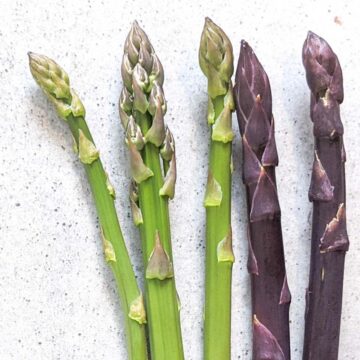
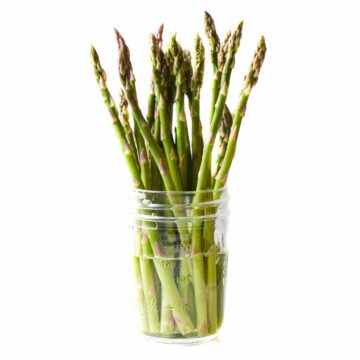


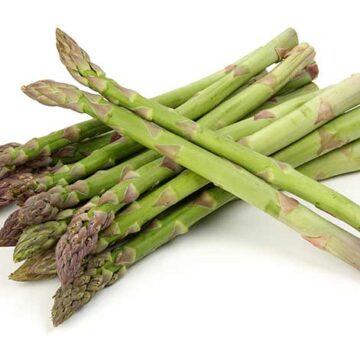
Zakład Pogrzebowy says
Your post is a true gem! It's packed with useful information, and I appreciate the practical tips you've included. Thank you for creating such a valuable resource!
Vee says
You're welcome, hope your asparagus growing goes well 🙂